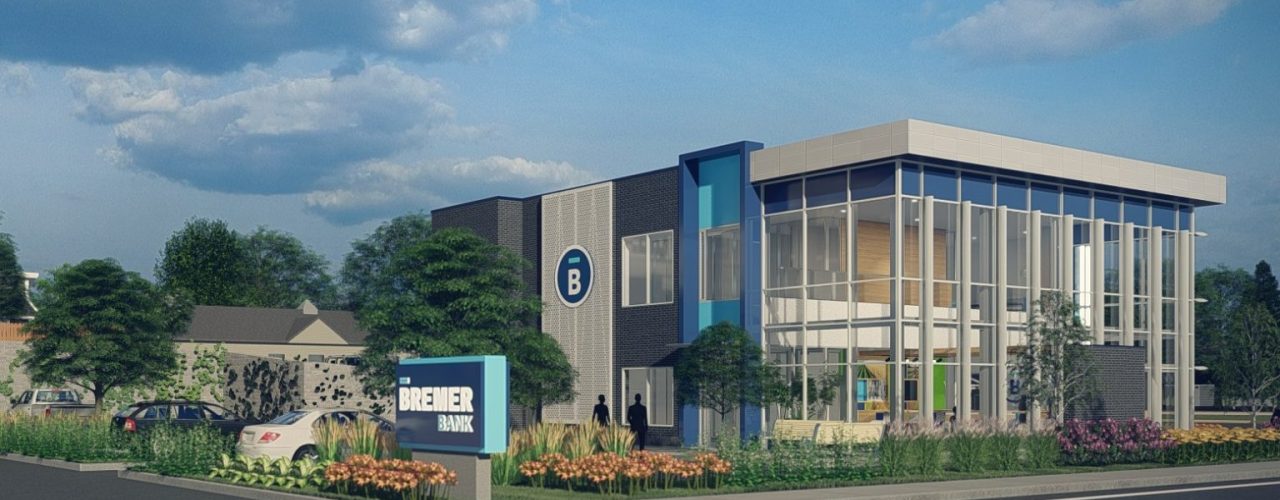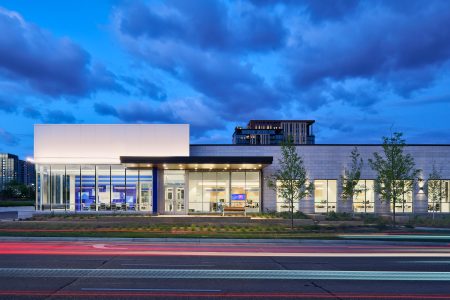5 Trends Shaping Retail Banking

The retail banking sector is in flux. Jackie Miller discusses how the industry is adapting.
Across the retail banking sector, things are changing rapidly. Last year, more bank branches closed than ever before, shattering the previous year’s record by 38%. But these stats don’t tell the full story. In fact, the savviest organizations are purposefully downsizing. They are taking this opportunity to give consumers more of what they want from the banking experience. Design, architecture and interiors are a cornerstone to their strategies.
Smaller Footprint, Bigger Experience
It’s true that most retail banks are downsizing. With major advancements in digital services, secure transactions and cloud storage, the need for vast square footage just isn’t there anymore. Specifically, the new banks we’re designing start from about 2,000 SF to 6,000 SF. That’s up from a typical footprint of more than 20,000 SF just a few years ago.
On the exterior, the pandemic accelerated zoning conversations that make drive-thru lanes much easier to implement. And on the inside, it’s all about connectivity and an inviting consumer experience. We are designing more open spaces that connect to outdoor patios with transparent curtain walls rather than solid dividers that break spaces into discrete sections. Coffee bars with smaller tables and soft seating make these newer spaces feel more like community gathering places. Instead of a wall of 3-15 tellers, we are designing smaller pods for more complicated transactions and private conversations. Overall, these are much more open, airy, organic spaces. On the operations side, these smaller, more functional layouts are allowing banks to be more strategic with staffing and make their entire business more focused on service.
Hospitality Influence Is Big
When people walk into a bank, they expect to feel welcome. Almost as though they are entering a hotel lobby or a restaurant. We are achieving that atmosphere with influences from the hospitality and even residential sectors. We are adding in soft, comfortable seating and dedicated areas for snacks and drinks. Again, this is the type of open floorplan that consumers have come to expect no matter the setting.
Retail Banking Going Green
Across the sector, sustainability is huge. Consumers are demanding it, preferring to work with organizations with a corporate sustainability mission. But it also makes a lot of sense from an operational standpoint. We’re working with our clients to integrate solar panels, geothermal loops and other eco-friendly systems that have an ROI of 10 years or less. Secure cloud storage and file backups have also made it possible to greatly reduce paper file storage. That means a smaller physical footprint as well as a smaller carbon footprint.
Common-Sense Conversion
Retail banking isn’t the only industry going through substantial changes. Shopping and dining have seen major transitions over the last few years, with the pandemic acting as an accelerating force. As it turns out, many of the quick-service restaurants that closed or downsized during the pandemic have an ideal floorplate for the latest iteration of retail bank branches. And as a bonus for the environment, the parking requirements for a bank are often much lower than for a restaurant, which means that we are typically able to replace paved parking spaces with plants and gardens.
Community Asset
In addition to coffee bars and workstations, some of our biggest clients are working educational and community-centered components into their projects. We are helping them plan flexible spaces so that, even with a reduced footprint, the bank can be transformed after hours. Our clients have big plans for community financial classes, group activities and team building events. From a design and planning standpoint, we are incorporating demountable furniture that can be rearranged after business hours and layouts that allow for 30-40 people to occupy the space with restroom access, but without any contact with secure areas.
As with the first four trends, making a bank a true community asset is part of a new business model. Banks are increasingly looking to turn their customers into brand loyalists and even brand ambassadors—adapting to these trends makes it that much easier.





